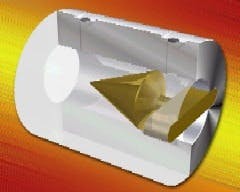Click here to see larger version of photo.Process and plant engineers with small line-size processes looking for precision flow measurement will find the versatile Wafer-Cone Flowmeter from McCrometer offers superior accuracy and repeatability, according to the manufacturer. The easy-to-install, space-saving instrument requires almost no maintenance. It is designed to have a long life and to reduce total installed and life-cycle costs. The Wafer-Cone Flowmeter is designed for liquid or gas service in line sizes from 0.5 to 6 inches, which makes it ideal for either small process lines or many plant infrastructure tasks. Applications for the Wafer-Cone range from chemical injection or filtering in process lines to general plant needs, such as lines for natural gas, chilled water supporting burners or ovens, cooling systems, HVAC and more. This flowmeter relies on differential pressure sensing technology; its flow sensor is designed with built-in flow conditioning to achieve an accuracy of +0.5%, with a repeatability of +0.1%. It operates over a flow range of 10:1.The Wafer-Cone Flowmeter is a real space-saver. It eliminates the need for extensive upsteam and downstream straight pipe runs required by other DP technologies, such as orifice plates and venturi tubes. It can be installed virtually anywhere in a piping system or may be retrofit into an existing piping layout, resulting in significant installation flexibility and cost savings.Unlike traditional DP instruments such as orifice plates and venturi tubes, the Wafer-Cone Flowmeter's design is inherently more accurate because the flow conditioning function is built into the basic flow sensor design. The Wafer-Cone conditions fluid flow to provide a stable flow profile that increases accuracy. The flow sensor's design features a centrally-located cone inside a tube. The cone interacts with the fluid flow and reshapes the velocity profile to create a lower pressure region immediately downstream.The pressure difference, which is exhibited between the static line pressure and the low pressure created downstream of the cone, can be measured via two pressure sensing taps. One tap is placed slightly upstream of the cone and the other is located downstream of the cone. The pressure difference can then be incorporated into a derivation of the Bernoulli equation to determine the fluid flow rate. The cone's central position in the line optimizes the velocity of the liquid flow at the point of measurement. It forms very short vortices as the flow passes the cone. These short vortices create a low-amplitude, high-frequency signal for excellent signal stability. The result is a highly stable flow profile that is repeatable for continuous accurate measurement. All of this is possible with a minimal straight pipe run of 0 to 3 diameters upstream and 0 to 1 diameters downstream from the flowmeter.To access a brochure on this product, click here.





